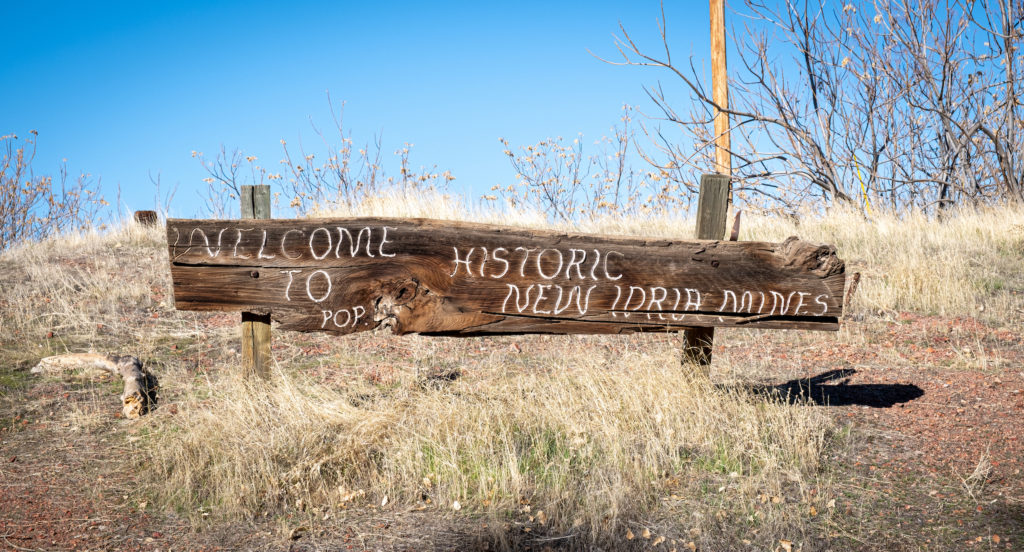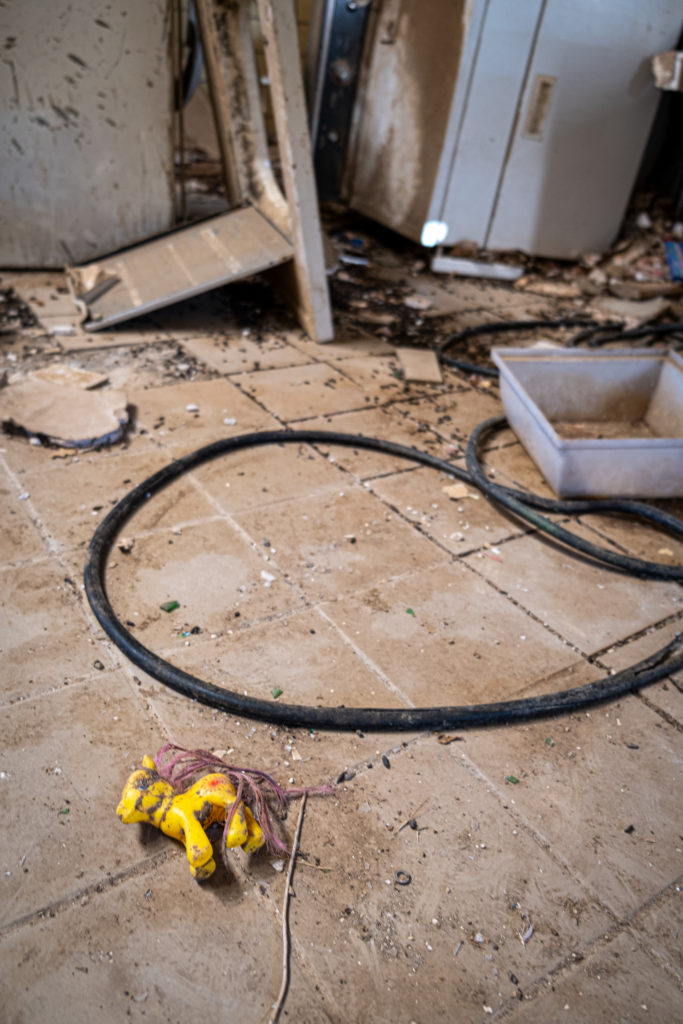
A Visit to One of California’s Most Hidden—and Toxic—Ghost Towns

Hannah McKelson
Editor’s Note: This is Part 2 of a two-part series documenting a visit to the California ghost town of New Idria. Read Part 1 here.
If at first you don’t succeed…
A first attempt to reach one of California’s most elusive ghost towns certainly didn’t go according to plan. To ensure I actually reached New Idria this time around, I contacted a local publication, the Benito Link, to follow up on any additional information regarding the washout—other than the fact that it existed—that had stifled my first attempt.
By some stroke of luck, the person on the other end was a journalist whose work had informed my original New Idria research. Leslie David had written about the one-time settlement in 2012, a year after the Environmental Protection Agency agreed to designate the mercury-plagued town as a superfund site.
David couldn’t provide any more information than the Bureau of Land Management, but she did have one question for me: Could the Benito Link write a story about my harried attempts to visit the mine? One of her reporters, John Chadwell, had written a novella about the town of New Idria and was eager to follow my steps—and stumbles—as I weaseled my way in.
After spending the better part of an hour on the phone with BLM, poring over topographical maps and tracing out routes, I learned I would need two permits, one for myself and one for my vehicle, to even access the land.
ENTER HERE, TYPE IN THE GATE CODE THERE. VEER OFF TO THE RIGHT ONCE YOUR REACH THE CHECKPOINT.
I repeated the instructions like a mantra, jotting them down in my field notebook and hoping they’d do me some good in the middle of nowhere. Alexander Mairs, a BLM representative, provided backup routes to the backup routes, and advised, come hell or high water, to hoof it two hours to the nearest peak to get enough of a cell signal to call for help.

Hannah McKelson
In the days leading up to the trip, I haunted off-roading forums and nagged the living daylights out of outdoorsy friends to furnish me with any serviceable gear they could spare. I subsequently purchased what seemed to be a quarter of the Earth’s water supply. In my own backpack, I had my essentials: Swiss Army Knife, mace, adapted lighter, first aid kit. Better safe than sorry rang truer than ever; I wasn’t in a position to take any chances.
At 1 a.m. the day of the trip, a storm rolled in. The wind shook the windows as rain came down in sheets, hammering the rooftop and leaving the driveway a pond. Four hours later, I was loading up the car. Rain in the North Bay didn’t necessarily mean rain along the Central Coast. Plus, I’d already put too much into preparing for the trip to be derailed by a storm system.
Once armed with coffee and cocoa from the local McDonald’s, I was off—three hours of driving through rural farmland and the high desert. Dark brooding clouds lingered across the horizon, blocking even the faintest sunlight. But the rain held off, and I continued on the series of dirt roads toward the BLM-instructed checkpoint.
“If you’d gotten here just a second ago, I would have kept it open for ya!” a cyclist said as I pulled up to the gate.
I fumbled for my permits as he rode off, looking for the gate code that would grant me access. My search quickly turned frantic. I couldn’t find it. Nothing. No code, no admission workarounds, and no cell service to call the number on the sign adjacent to the barred entry.
I had no choice. I threw the car in reverse and drove, one hand on the wheel and the other elevating my phone toward the sky, praying that my wingspan would be the difference maker. I pulled off at nearly every summit—still nothing. The sky grew darker. Even if the storm held off and I located an ever-elusive signal, I’d still need to get back to the starting point with enough time to off-road my way to the mine. The clock was ticking.

Hannah McKelson
Fifteen minutes from the nearest town, I finally got it: A signal (if you can call a lone bar a fully-fledged signal). And while it was enough to complete a call, the automated answer on the BLM office number provided a cruel reminder that the Bureau is closed on weekends. Thank God I had Alexander’s work cell.
“I’m so sorry to bother you…” I sheepishly began.
The amicable Bureau rep that he is, Mairs offered a fix, rattling off a number of codes that could work. I scribbled them down and sped off toward the gate after a series of profuse thank yous.
When I finally gained access, the land I saw on the other side was the epitome of desolation.
Bare mountains were cut by quicksilver streams, dotted with desaturated pines, and lined with antiquated trails. Interminably rocky roads shook my car as it climbed toward the peak—or where I guessed the fog-blanketed peak was.
An eventual descent amidst increasingly dense forest yielded views of the undulating mountains and flatland where I had gotten stuck weeks prior. Somewhere out there, scarring the road, was the washout.
Impossibly, the county road I had turned onto was actually worse than the road I had just departed. The rain from weeks prior had left new washouts, creating deep canyons in the road that, at multiple points, necessitated “floating” a tire down the middle—the other three providing stability.
After more than a few internal organ jolts, I made it down safely. Nestled at the base of craggy mountains and scrub-covered hills was what appeared to be nothing more than haphazard piles of rust and wood.
This was New Idria.

Hannah McKelson
In recollecting it I can only describe the place as a basin of quiet. There was intermittent birdsong from unseen sources, but I saw no other living thing. No rodents in the surrounding vegetation. No insects stirring in the air.
I parked my car and grabbed my camera before jumping out to a world where everything appeared out of place. A metal desk scrawled with graffiti sat unattended. A single rusted basketball hoop stood like a mast in front of what once was a home; the shadowed extraction plant loomed in the background. An eerie “See you!” written on the side of a house greeted me as I walked. Devoid of a front door, the entryway had an illegible warning posted next to it: something about the hantavirus.
I peeked inside, covering my mouth with a makeshift bandana. The building was littered with rodent feces—no surprise—and an inconceivable collection of trash. That, too, was no surprise.
Thirty years ago, a developer from San Jose named Sylvester Herring acquired over 880 acres of the surrounding land and started a more-than-shady “drug rehab program” called the Futures Foundation. “Patients” were used to truck in garbage and construction debris, turning the once-bustling mining town into a filthy landfill. (Oddly enough, New Idria was also once the site of an illegal Rottweiler and Shar-Pei breeding operation.)
It wasn’t until 2002 that Herring was ordered by the EPA to pay a $150,000 fine within a 20-day span in order to clean up “hundreds of tons of hazardous junk and solvents he unloaded,” the fine stated, as if rampant mercury and asbestos weren’t enough of a problem already.
If a cleanup was undertaken with the $150,000, it certainly didn’t look like it.

Hannah McKelson
I kept walking. What must have been some sort of convenience store still had cans of Campbell’s Soup basking in dust-filtered sunlight on musty tables. The shelves were still partly stocked with Hidden Valley dressing, prompting curiosities as to what sort of consumers would come here for their groceries. The rehab patients? Unlikely. Locally famed journalist Kate Woods? Doubtful. These odd items belonged to a time recent enough to be recognizable but too distant to inspire physical contact.
I wandered further into the building, stepping gingerly over skeletons of furniture into what was once a laundry room.
On the tiled floor was a single figurine—a yellow My Little Pony horse like the ones I played with growing up.

Hannah McKelson
Outside was an even stranger sight. Nothing more than the front face of an A-frame church, white and blue with a cross at the apex. A starburst of sunlight filtered through the ghosts of tree branches hanging overhead an area that once harbored a podium and pews.
I snapped a few photos, then something caught my eye. A gaping hole in chain link fencing around the extraction plant, cut next to a sign that read: “Danger-Keep Out Dangerous Mercury in Air and Soil.”
I bolted towards the fence and saw the hole was an adequate height to squeeze through. If I had a moment of hesitation, it was gone in an instant, and I was in.
Like most of the buildings, the extraction plant was a haphazard structure of rusted sheet metal, wood, and concrete. Teetering across a pile of wreckage that threatened to cave with every step, I reached the entryway. It was four feet off the ground, and I pulled myself up on my elbows, sustaining a single splinter in the process.
Exposed beams and imposing metal funnels greeted me; the extraction plant was a labyrinth of nonsensical stairwells with less-than-stellar structural integrity, which I promptly scrambled up to reach the next floor, ever cognizant of the omnipresent mercury.
I climbed up another floor, then another, crawling on hands and knees and stooping under low ceilings. A stair gave way beneath my feet, taking my breath with it. Finally, I made it to the top floor. The wooden slats that supported me were unstable. Huge mills covered in chain link took up most of the space. To my right I saw a catwalk, and a little further, a cross. From this height I was eye to eye with the barren mountains. The wind made the building creak in warning.
Before pressing my luck any further, I carefully tip-toed my way to the nearest stairwell, which I gingerly inched down toward the Earth.

Hannah McKelson
Once on solid ground, I saw the light had softened, the remaining glow pointing to a lone chimney that remained almost completely intact. It stood, solitary, in the middle of a field of cottonwood saplings that never reached maturity.
I picked up a piece of porcelain tile to examine it. Admiring its cerulean blue figure, the thought of bringing the tile back as a souvenir crossed my mind. The impulse passed with a shudder and gave way to apprehension.
I’m not superstitious per se, but I immediately scanned my environs for the closest bush of wild sage, crushing it between my fingers and rubbing it on my pulse points in a makeshift rite of cleansing.
The sun was setting behind the hills, turning the mountains to flames. And as I drove off I was certain. It was good I left the tile.
